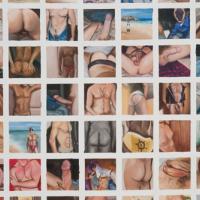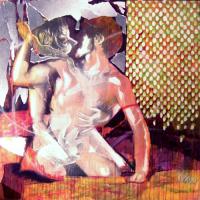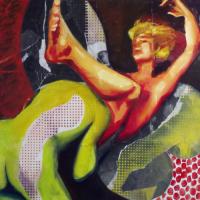My work is an investigation of a particular demographic specific to the Washington D.C. area, but, in spirit, it can also be representative of other communities. My new work is a portrait of how contemporary gay society takes advantage of the Internet and technology as a means of creating connections. The Internet has sparked a flaming society that devours images and creates possibilities for snapshots to be saved and downloaded by anyone. When an image is saved and downloaded, the subject is unable to control how his image is being presented to others. Images of ourselves are being excreted like sweat in the age of Facebook, social networking, and the digital camera. By combining selected images and charting random images, I hope that my work coalesces into a portrait of how the gay population of the metro Washington DC area chooses to present itself in the context of free, open media. In addition to being a portrait of the local digital gay population in amorous attempt, the work takes into question how society as a whole might create relationships differently than ever before.
The assimilation of meaning through multiple images is something that has been consistent in my work and stems from an interest in comics and sequential art, an interest that also has relevance to the graphic structure of personal ads on websites. I have worked in the comic industry and understand both as a reader and an editor how a narrative is constructed through a series of pictures. The formats of various dating websites cater to a diverse spectrum of desires and needs, and the overall aesthetic of its user’s avatar images can do wonders in conveying these ideas. For example, a website like Craigslist is full of ads that show nothing but genitals, highlighting the fleeting and exclusively sexual nature of the type of connection that the website offers. I am interested in how the output of these images creates an expectation of what is desirable, essentially training and conditioning our desires.
These dating websites present images that men independently create with their own cameras and feed to other men in order to initiate some sort of romantic or sexual encounter. This awareness of home production might open up a window to what gay men think other gay men are interested in. In my thesis exhibition, the format of my large painting emphasizes Craigslist avatar identities. Each image has been painted quickly, in no more time than a sexual encounter that may or may not have happened. In addition, my drawings also utilize profile images from various other gay dating websites. I have chosen images of men that were matched for me, according to my profile, as well as men that I’ve met on the websites who were not a good match.
In doing this, I hope to question the role of photography in how men choose to create their digital personas. What do they see as masculine, virile, and impressive about themselves, or their interests? By amassing avatars of gay men’s personal advertisement websites and presenting them as small images, which are true to screen size, I also call into question ideas about the ownership of images, especially social media images. What does it mean to take something from the worldwide web and put it in a private museum? My work explores broad issues of being gay and my private issues of personal identity within the community, and how this may or not be different from other men. By taking on the evolving image that the community is creating for itself, my work captures what is going on at the moment and expresses my own relationship and involvement in something that I find poetic, humorous and gross all at the same time.





